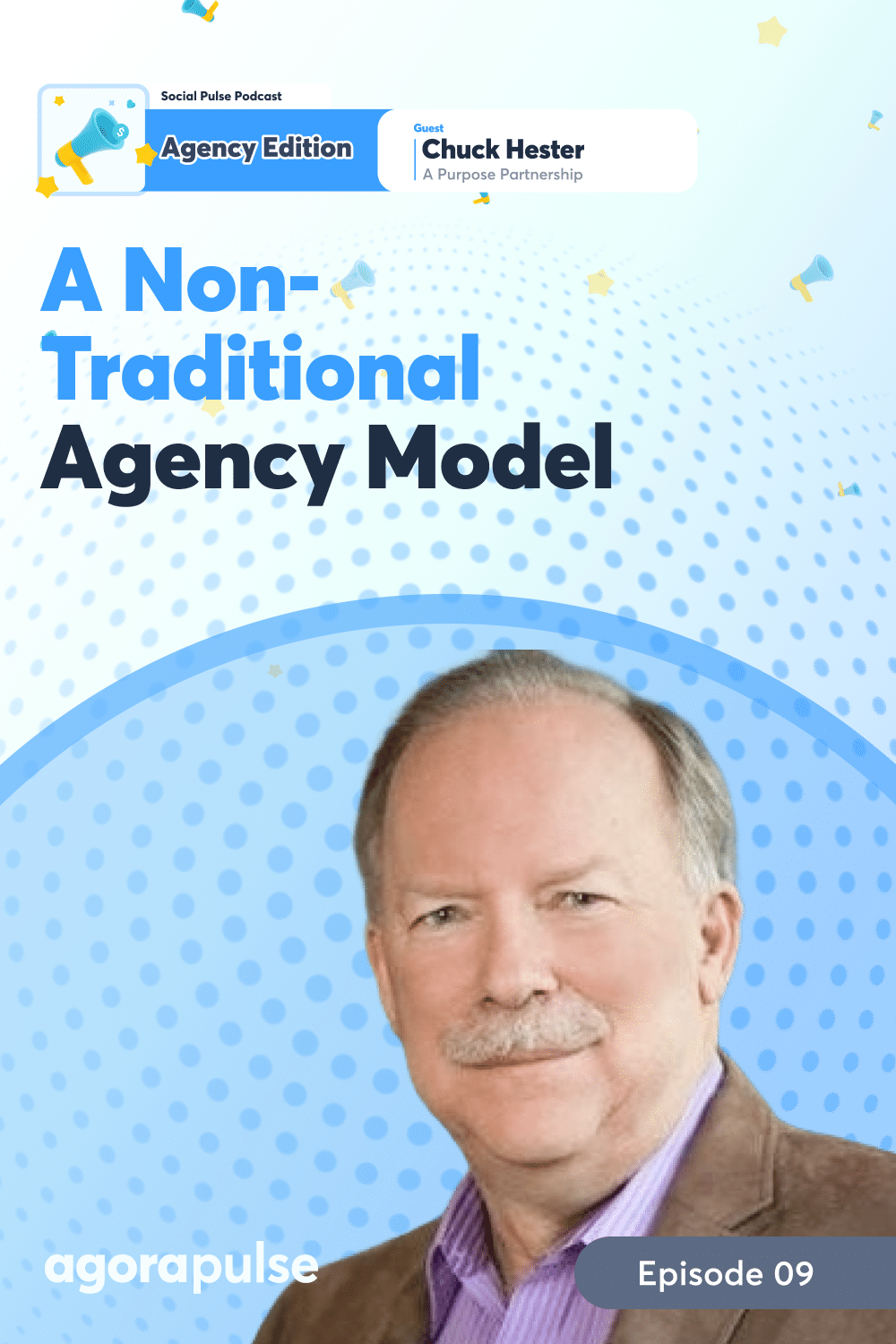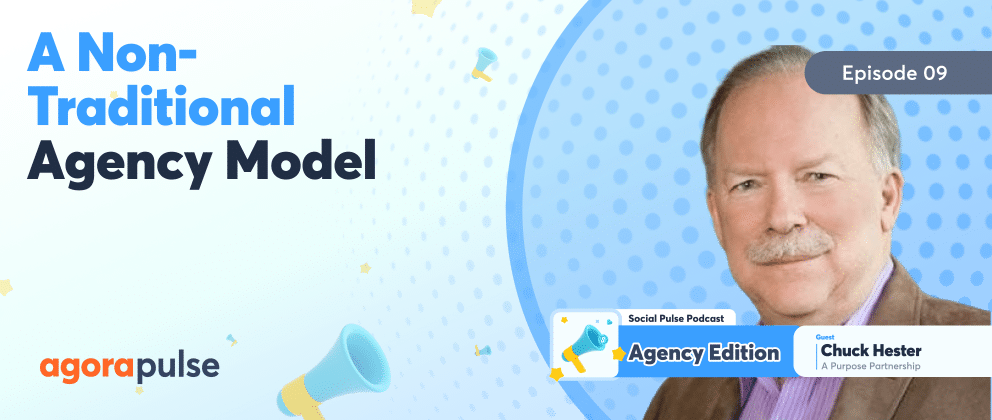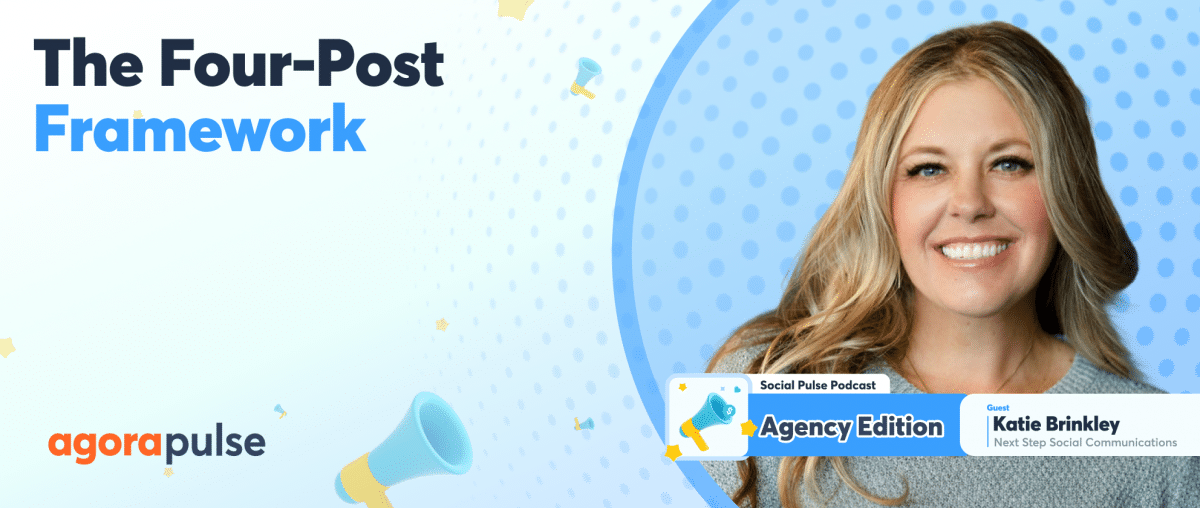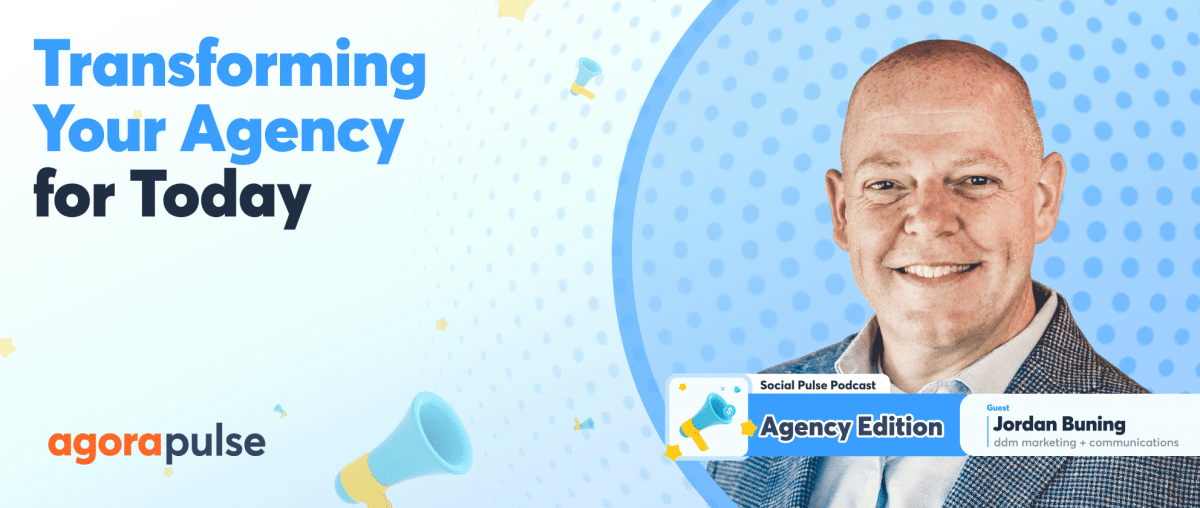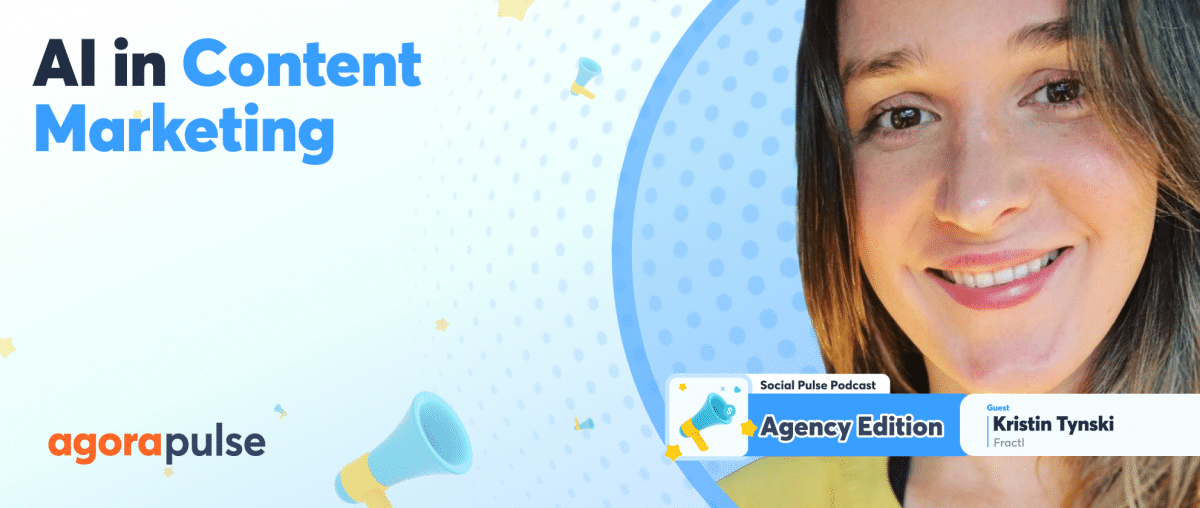One of the reasons so many agencies close within three years is that the owners simply burn out from the overwhelming workload, late nights trying to hit deadlines, and long meetings in the morning with clients who are always right. And there’s that constant trend of clients who weren’t a good fit.
What if you had a different way, maybe even a better way, to structure your agency and approach working with clients? If the traditional agency model is broken, how should we approach doing great marketing for clients?
That’s exactly what Chuck Hester is going to talk to us about in this episode of Social Pulse Podcast: Agency Edition. You can hear the entire episode below or read on to get the highlights of the transcript.
Chuck is a nationally renowned marketing trainer and speaker who helps businesses get the most out of digital channels. He’s the co-founder of A Purpose Partnership, a contrarian marketing and business consulting firm that works with its clients at all things marketing, from public relations to web development to corporate social responsibility.
What Is a Purpose Partnership?
Mike Allton: Let’s start off by talking about this anti-agency that you’ve created. Tell us about A Purpose Partnership and why you called it an anti-agency.
Chuck Hester: A little background: I’ve been in public relations marketing for close to 40 years now. That’s what we’re going on. Multiple agencies, all with the same issues that we run into. The best way to describe it is embracing what is known as the night shift. Nine to five, go have dinner with your family, and then come back and work till midnight.
Burnout, as you mentioned, is a typical thing that occurs. My partner Adam Sinkus and I got together. I was working with a particular agency here in Raleigh, North Carolina, and parted ways with them and said, “There’s got to be a better way. There truly, honestly, has to be a better way.”
We created A Purpose Partnership, and both those words are part of it.
We are very intentional. It’s how we do it. We work with a purpose, strip away the negatives. We work with the positives, and partner with our clients and our subject matter experts—as opposed to being a vendor and working those guys to death.
The anti-agency aspect of it is a couple of things.
As I mentioned, the night shift doesn’t occur with us. We have boundaries that we set for our clients and for our team in a positive way. At the same time, we’re not helicopter CEOs, which is the best way to describe it. We don’t come in at the last minute because a client calls the owner and says, “Hey, you know, your team isn’t doing it the way I want it to do.” And they come in and say, “Well, okay, the client’s right.”
That’s the bottom line. We work with our clients. As partners, we meet with them. We have three managing partners, two co-founders, and a managing partner, and we meet with them every single week. Our other tagline is: strategists that do the work. We actually get in there, work with them, and become a true partner for them.
Mike Allton: Let’s dig into some of those negatives a little bit because I know there are things that you’ve addressed that are negative, both from the client’s perspective and from the agency owner’s perspective. So let’s focus on the agency owner’s perspective for a minute, like working late nights to get the sense.
Problems and Issues That Agencies Face
Chuck Hester: We run into a situation where there would be late-night phone calls from an agency owner for somebody who was a VP. Saying, “Hey, you need to address this right now. The client is concerned about it. I want it done.” Now, the way we work at A Purpose Partnership, if we get an email from a client (unless it’s an absolute emergency like a website’s down or something going on), we’ll wait till the following morning to address that, within the office hours. While we’re not training our clients, per se, we’re giving them the way we work in such a way that they are very comfortable with it.
That’s a big aspect of it as well.
Then the other part of that is the burnout. I mean, what we call checking the boxes. “Hey, we’ve got a great culture and we’re going to do some really cool things. And, you know, we’re going to do team building and all of that stuff.” Check the box, check the box, and then don’t follow through.
All of our folks are senior-level folks. But they have an affinity for each other. They work well with each other. Our clients love what we do on status meetings, for instance, including small stuff like, “Hey, let’s, have a conversation about, you know, their personal lives and what they’ve got going on.” I’m infamous on Facebook for my dad jokes. They always ask for my dad jokes.
But we’re actively involved with them on a weekly, daily basis, and they respect that. And the other side of that is if they do not—or if they have issues—we have them fired.
We fired three clients over the last two years because they were causing issues, micromanaging, whatever it may be. That’s what we call the stripping away the negative.
Mike Allton: So you mentioned earlier that this is not your first agency. You’ve been through a number of agencies.
When did it occur to you that you really needed an entirely different agency model that was needed? And how did you go about setting that up?
Chuck Hester: I have the privilege of working with a really good friend of mine, and that’s Adam Sinkus. Believe it or not, we met on Telegram, and that is still active, not as active as it used to be, but we were both LinkedIn enthusiasts, and we joined a group, got actively involved with that.
We created a thing called Pay It Forward Tuesdays, which is a nascent 501(c)(3) that mentors small businesses. And we picked non-underserved entrepreneurs and nonprofits that we work with.
Long story short, Adam and I started close to three years ago having conversations of: Why is this not working? Why are we having difficulties? He was my sounding board at agencies that I was involved with a couple of different ones over the time we knew each other and we said, when at the time when it was an opportunity to, what are you going to do next, basically for me, it was a case of “Why don’t we try to do this together?”
Because, and the best way to describe it, Adam’s my left brain. I’m his right brain. And we meet in the middle with a third managing partner who does a little bit of both. We call her the Venn diagram, so that’s where we come from.
Mike Allton: I imagine that this kind of a model has its own interesting opportunities as well as some issues. Can you share a little bit about what those might be?
Chuck Hester: Yeah. And the model, to walk it all the way through, we have three managing partners, but we then have another eight subject matter experts on demand as we need them.
And that’s the other part of the anti-agency. We go to our subject matter experts. When we have an opportunity, we sign a new client and we come to them and say, “Hey, you know what? Stephanie, this is something that you might be interested in. Look at the client.” See, make sure your subject is something you want to be involved with. Let us know as opposed to an agency that finds a new client. And then comes in and say, “Hey, Mike Allton, guess what? You’re now working on Acme Company.” And whether you want to or not, we use that pitch in new business, and you end up with a very passionate team at the same time, those folks are passionate about what they do and they deliver really good, content and project work.
That’s the bottom line.
The negative that we run into is: Engaging all of those subject matter experts enough to keep them engaged and involved. And at the same time, folks that may try it out over the last couple of years, we’ve had several folks who have tried this out and tried to work with us, but then realized they need the steady paycheck. They need to be able to have the benefits, do whatever. And we’ve had several go back to full-time but still keep in touch.
Mike Allton: That makes sense because when I first read your description of this model that was actually one of the first thoughts I had, it’s like “Oh, if I can pick or choose what projects I do or do not want to work on as one of your consultants,” that seemed to me immediately to be a bit of a challenge to keep me busy or to find the rank consultants for clients. I’m also wondering about the clients themselves, so I imagine a lot of businesses come to you with their own baggage when it comes to working with agencies, some expectations maybe of how things are going to work. How have you worked through that?
Chuck Hester: Honestly, that’s one of our larger new business opportunities where we run into folks that I’ve tried agencies, and they keep screwing me or whatever the problem may be. We run into that, and we burn out on agencies.
One of our founding principles is that we want to work with clients who are passionate about what they do and aren’t necessarily passionate about marketing. I mean, one of my favorite clients is about a year or so ago, came to us and said, “I hate marketing.” And that couldn’t be a better thing for us to hear because we love marketing and our philosophy there is we want you to do what you’re passionate about.
Entrepreneurs, small businesses, whoever it may be, go do that. We’ll take care of the marketing, and I’m going to bring you in when it’s time to bring you in. So it’s worked very well.
Having to fire agency clients
Mike Allton: You mentioned earlier that you’d fired two or three clients, I think you’d said, within a certain amount of time, which to a lot of agencies, that might sound shocking. A lot of folks that I’ve talked to have never fired a client, and they might have their reasons for doing that or not doing that, but I’d love to know from you what shouldn’t clients do and what might get them fired specifically? Some examples would be great.
Chuck Hester: Sure. The best way to describe it is that if you are engaging an agency because of their expertise and what they’re going to be able to do for you, don’t tell them how to do it. Understand and collaborate with them as you go through, we do a lot of six-month to a year marketing programs that we’re putting together.
One of the clients that we fired was a micromanager. I mean, he came in on a regular basis and said, “No, this particular sentence doesn’t work in your social media. We need to change it to those types of things.”
The ones that we are successful with and do well with are the ones that say, “You know what? We trust you and hired you because you are experts in your field, go do your thing and then collaborate with us and give us issues that we run into so that we can work through them together as partners. but again, the ones that, we have really let go.” I mean, there’s always going to be folks in the agencies where there’s non-payers.
I mean, that’s one of the things, but the other part of that is the micromanagement aspect,d it’s hard for an entrepreneur who’s built their baby up from zero to 1 million, 2 million, whatever. And they feel like they need to be involved in every single aspect of that business, including marketing.
And that’s where a lot of the entrepreneurial, small to medium-sized companies fail. Because they have owners or a team that really feels like they have to be actively involved and they can’t learn to trust the experts that they brought in to surround themselves with.
We’re the same way. We have experts in a several different areas that it’s taken a little while because both Adam and I were solopreneurs for a long time to be able to let go and say, “You know what? I put this person in that place because she’s really good at what she does. And I’m going to go let her do that.” So, that’s kind of the bottom line.
Mike Allton: When you’re working with a client like that in the early days, obviously not at the point where they’ve micromanaged or whatever, you’re done, but early on and you start to sense that, “Okay, this is one of those micromanaging clients.” They want to be overly involved.
Building trust with agency clients
Are there any things that you’ve done to try to establish more trust and rapport with that client that maybe have been a little successful and gotten some clients away from that mindset?
Chuck Hester: Part of that is developing strategies and tactics and then executing on them and then allowing that client to see the results of what we’ve done. If we’re promoting a webinar and we’re using organic social media, not spending a dime on digital, and then we fill that room, then that can be one way to say, “Hey, you know what? This is working. This is working really well.” As you know, I call myself a LinkedIn maven. I hate the term expert, but using LinkedIn in such a way, I do LinkedIn one-on-one training with some of the clients and they go, “Oh, okay, cool. Chuck knows what he’s talking about. So let me give him some leeway and let him do what he’s doing because he’s doing very well.”
Mike Allton: The key message there is: Do the work, get some results, and make sure those are communicated to the clients.
Measuring success
I want to know how you’re measuring those results, particularly when, as you talked about organic social media, sometimes it’s great if you’ve got a webinar and you can actually see X amount of people signed up and then you can measure their pipeline impact. But a lot of organic social media doesn’t always have that, or that direct correlation to business success.
How are you measuring it for your clients?
Chuck Hester: We are fortunate enough that LinkedIn is really good when it comes to analytics, be able to work that through, our managing partner, our director of Content Marketing, social media, is really good at putting analytical.
And we will do a quarterly report on how things are going, what does it look like? We work with senior VPs to being able to see their LinkedIn or their Facebook or wherever they happen to be starting to get traction. And we will point those ones out.
Again, as I mentioned earlier, we meet with our clients on a weekly basis. If there’s something that comes up, where we’re seeing, “Hey, you know, Mike Allton has been mentioned 1,015 times in a particular post that we did.” We’ll bring it up, because we want to make sure they are of what’s going on.
The hard and fast analytics is really on the more on the digital side as to website visitors and the Google analytics that Adam and his team are really, really good at. As you mentioned, we learned as we go along, but we don’t over-communicate, but we definitely communicate with our clients.
We have a status meeting the following day. And there is a recap document that goes out with deliverables and things that the client needs to do. And we need to do with hard and fast deadlines, as to when we’re going to do that, because we found, “Hey, we make assumptions sometimes that the client was listening on the status update, they knew what’s going on.”
It’s always a very busy environment that you’re dealing with entrepreneurial organizations and agencies.
Mike Allton: From what I’m hearing, I know there’s a lot that you do that’s very similar to a traditional marketing agency. You’re doing marketing like anybody else, and a lot of that doesn’t change.
But I’m also curious about what is different in terms of your approach with clients and hoping maybe you could share one or two examples of projects or clients that you’ve worked on that just felt like they were a totally different approach.
Chuck Hester: We have one client currently, a gentleman who runs an organization called Brands Constellations. And it’s basically a one-on-one branding course that he has put together and consultation that he does with that. He considers us part of the team and he considers us part of his success as he goes on. Steven Silverman is a different person, and he is a marketer and understands former Microsoft, totally understands it, but at the same time, he also understands he doesn’t know everything.
So we’re able to work together with my team and the three managing partners that are on his team. Those are the primary folks that work with them. But we work with Steven to the point where he can send an email and say, “Hey, you know what? I just need your opinion on this. What does this look like?” He doesn’t consider us an agency. He considers a success partner. That’s the way to describe that.
It shows in what we do, and we personalize it as well. He’s based in Chicago. I went up to see him in Chicago recently. So, there is personalization that goes along with that with caveats, making sure that there are professional boundaries in that, but it works very well. That’s a good example of a partnership that we work with Brand Constellations.
Mike Allton: That’s a great example and I love that you keep using the word partnership. A lot of times agencies were talking about clients and customers and that’s vendor relationship. But this is a different kind of relationship.
I think it’s important to have healthy boundaries in place.
You have set expectations, there’s a high level of communication there. Not overcommunicating necessarily, but definitely a high level of communication. A really successful partnership.
What’s in Chuck Hester’s Tool Stack?
Now one thing I wanted to ask: We haven’t really talked about tools. And I’m wondering what tools are you guys using? Is there anything that you’re using again, that maybe is a little different from a traditional agency? Maybe not, but I’m just wondering if there’s something out there that you’re using, that that’s uniquely helpful to this kind of a model.
Chuck Hester: Well, I would be remiss if I didn’t say Agorapulse is one of our major tools that we use, and we love that platform. We were talking about that pre-show, but we’re very careful not to be wrapped up into the technology. And we’ve talked about communication.
When we establish a relationship with a client, we figure out, “Okay, what’s the best way to communicate with that client?” We love Slack. And we use it for a variety of things. We do like Zoom. And both Adam and myself are podcasters, so we’re using StreamYard. And I am using StreamYard. We just recently did a Q&A with the security director for one of our software company clients, using StreamYard and it was raw video on, I’m off camera asking questions, he’s answering questions, and we’ll edit that down into a video and be able to use it that way.
We’re very careful. We’re also very lean. So, we try to stay away from some subscriptions, as far as that goes. We’re dipping our toes—as well—into AI. We definitely use ChatGPT on a regular basis, but we have one of our content creators.
Mike, I think you and I were up in November at Ann Handley’s conference. And we were talking specifically about the new position that could happen as an AI Editor. Our folks will do blog posts using ChatGPT, but then we go back in and put client voice to it. That’s happening a lot professionally, as well. I’m using it for status updates for LinkedIn but also retooling some of my LinkedIn articles.
A point on all of that is we are more human than we are subscription and tech stack, but there are certain things that we definitely need to use as far as that goes.
Advice for Agency Owners
Any final advice that you might want to share with agency owners who find themselves struggling with these late nights, work sessions, evenings, weekends, holidays, phone calls from clients, expecting them to respond and act?
Final Words of Wisdom
Chuck Hester: A couple of things.
- Set the boundaries at the beginning of the relationship. Understand that this is what this looks like. My partner Adam is much better at it than I was. He trained me basically of getting an email at nine o’clock at night. That isn’t terribly critical. Not answering it till the following morning at eight or 9am. Took me a long time to not immediately respond, especially since I was developing some personal relationships with some of my clients.
- Don’t chase money. But the other part of that is we ran into trouble first year when, for a lack of a better way to put this, we started chasing the money. In other words, “Hey, let’s take this client cause they can pay the $10,000 a month retainer, $5000, whatever it was, and we’ll deal with all of the crap that we have to tool it up with this person in order for the invoice to get paid.”
When we stopped doing that and we, a lack of a better way to put that, loosen the grip, if you will, on that aspect of it, the clients came in, they, they started working really well and then of the eight. Subject matter experts, team members that we work with, almost every single one of them came to us because they wanted to do some freelance work or whatever. And they were toying with going back into corporate. And then they realized, “I really want to do what I’m passionate about.”
That’s the first question we ask when we’re talking to them. “What gets you up in the morning?” The cliche question, but really if you could not do anything else for the rest of your life, what would you want to do professionally?
Sometimes, it wasn’t that corporate job or working for somebody else or whatever it may be.
Follow your passions. I mean, we do that to the person on a regular basis daily here at A Purpose Partnership and we’re having a ball doing it. It allows us to do other really fun things. I’m now a correspondent for a local tech choir, organization and doing some journalism, but I’ve always been a writer.
Long story short: There are things that our folks love to do. And when they get a chance to just do that, they flourish. They really have a good time doing what they’re doing.
Mike Allton: Great advice. I particularly appreciate your point about taking clients for the sake of the money.
I get many of you listening to me right now may not be in a position financially to say no to an incoming project. It may be exactly what you need it right now—despite the work or whatever. But those are the clients to our earlier conversation. You probably need to offload and potentially fire at some point when you can afford to bring in some additional clients and bounce that workload.
Chuck, this has been so much fun. I appreciate you sharing this so much background in terms of what you’re doing today and how and why.
Don’t forget to find the Social Pulse Podcast: Agency Edition on Apple and drop us a review. We’d love to know what you think. To learn more about Agorapulse, check out our website, and get into contact with Mike Allton on LinkedIn. See ya.
